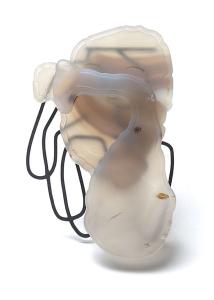 Ruudt Peters is a force. He is everywhere, it seems, with an irrepressible energy. He lives in Amsterdam, but you can find him in Mexico, India, Sweden, China, and numerous other places on a regular basis. You could even find him on the AJF jury recently for the Artist Award. Over the years, he has made it a habit to investigate cultures unfamiliar to him when he was ready to start a new series of jewelry. His curiosity drives him to learn about the spiritual inclinations of each place and come up with a way to express it. He is adventuresome, and with each series he changes the idea, the medium, and the technique he uses to make his jewelry. It is a bold way to work. This new show at Galerie Rob Koudijs is a result of his trip to China and his research about Qi.
Ruudt Peters is a force. He is everywhere, it seems, with an irrepressible energy. He lives in Amsterdam, but you can find him in Mexico, India, Sweden, China, and numerous other places on a regular basis. You could even find him on the AJF jury recently for the Artist Award. Over the years, he has made it a habit to investigate cultures unfamiliar to him when he was ready to start a new series of jewelry. His curiosity drives him to learn about the spiritual inclinations of each place and come up with a way to express it. He is adventuresome, and with each series he changes the idea, the medium, and the technique he uses to make his jewelry. It is a bold way to work. This new show at Galerie Rob Koudijs is a result of his trip to China and his research about Qi.
Susan Cummins: Please explain the Qi project.
Ruudt Peters: Qi is the energy of life. It is Chinese alchemistic knowledge. I traveled through China for three months in order to be in touch with the Chinese alchemy of Qi. During my stay, I found out that there is a big difference between the East and the West in their approach to life. The Chinese are more holistic in their view of life/health and the mind/body relationships. Chinese alchemy is a mixture of Taoism, herbal medicine, acupuncture, and tai chi. It is based on real life. I tried to get all these influences and ideas into my work. I got crazy about it, and so in the end, I decided to make a blind drawing daily. It was a way to keep the memories alive.
For two months, I traveled around the country researching, and then for the last month, I stayed in Xiamen at the Chinese European Art Center (CEAC). During that time, I worked with ceramicists and stonecutters who took the blind drawings and began to laser cut and etch the stone into brooches. By the time I left, the project was halfway finished, but I continued to work on them from Amsterdam through emails and translations. Also after I came home, I worked out how to treat the 99 individual ceramic men who represented the body experiences of acupuncture, cupping, stone massage, goose bumps, anxiety, crying, craziness, affection, and other feelings. Then, I went back to China for four days to work on the figures to make each one feel like an individual. Then, I had all the work shipped back to me, and when they came, I was even surprised by how they looked.
 Ruudt Peters is a force. He is everywhere, it seems, with an irrepressible energy. He lives in Amsterdam, but you can find him in Mexico, India, Sweden, China, and numerous other places on a regular basis. You could even find him on the AJF jury recently for the Artist Award. Over the years, he has made it a habit to investigate cultures unfamiliar to him when he was ready to start a new series of jewelry. His curiosity drives him to learn about the spiritual inclinations of each place and come up with a way to express it. He is adventuresome, and with each series he changes the idea, the medium, and the technique he uses to make his jewelry. It is a bold way to work. This new show at Galerie Rob Koudijs is a result of his trip to China and his research about Qi.
Ruudt Peters is a force. He is everywhere, it seems, with an irrepressible energy. He lives in Amsterdam, but you can find him in Mexico, India, Sweden, China, and numerous other places on a regular basis. You could even find him on the AJF jury recently for the Artist Award. Over the years, he has made it a habit to investigate cultures unfamiliar to him when he was ready to start a new series of jewelry. His curiosity drives him to learn about the spiritual inclinations of each place and come up with a way to express it. He is adventuresome, and with each series he changes the idea, the medium, and the technique he uses to make his jewelry. It is a bold way to work. This new show at Galerie Rob Koudijs is a result of his trip to China and his research about Qi.
Susan Cummins: Please explain the Qi project.
Ruudt Peters: Qi is the energy of life. It is Chinese alchemistic knowledge. I traveled through China for three months in order to be in touch with the Chinese alchemy of Qi. During my stay, I found out that there is a big difference between the East and the West in their approach to life. The Chinese are more holistic in their view of life/health and the mind/body relationships. Chinese alchemy is a mixture of Taoism, herbal medicine, acupuncture, and tai chi. It is based on real life. I tried to get all these influences and ideas into my work. I got crazy about it, and so in the end, I decided to make a blind drawing daily. It was a way to keep the memories alive.
For two months, I traveled around the country researching, and then for the last month, I stayed in Xiamen at the Chinese European Art Center (CEAC). During that time, I worked with ceramicists and stonecutters who took the blind drawings and began to laser cut and etch the stone into brooches. By the time I left, the project was halfway finished, but I continued to work on them from Amsterdam through emails and translations. Also after I came home, I worked out how to treat the 99 individual ceramic men who represented the body experiences of acupuncture, cupping, stone massage, goose bumps, anxiety, crying, craziness, affection, and other feelings. Then, I went back to China for four days to work on the figures to make each one feel like an individual. Then, I had all the work shipped back to me, and when they came, I was even surprised by how they looked.
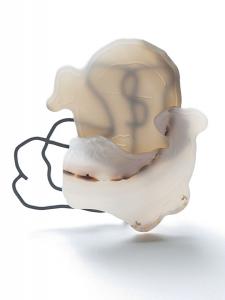
Ruudt Peters: For me, unconsciousness is the mother of creativity. Without looking at the paper, I have a feeling that I am in a close relationship to my belly, the female part of myself. When I draw blind, I am totally “one” with my pencil. The outcome is much more free than when I look at the paper and direct the pencil via my brain. I believe that the combination of my hands and belly are stronger than my brain.
In your video on You Tube, you reflect on Qi and the illness you discovered you had when you returned from China. What do you make of the fact that your body knew you were sick before your mind did?
Ruudt Peters: It sounds strange, but for me, as an artist, I was very happy that what I had always proclaimed came true: “Draw blind if you would like to know what you want to tell the outside world.”
For sure it was a shock to hear that I was sick, but to know that my unconsciousness knew before I did gave me the power to get over the illness. Artists have the privilege of making art as the outcome of their life experiences. It is very powerful to stay in touch with yourself.
You are very unique within the international contemporary jewelry field. Who else makes a lifetime of work related specifically to spirituality, mysticism, and alchemy?
Ruudt Peters: I don’t feel unique. I am just doing what I have to do. I think other people have to do this, too. We should use our talents to make a contribution to the planet by creating meaningful work/jewelry to put into the world. This changes the world in a positive way. As I grow older, I become clearer about my choices. I don’t like to bother myself with issues of what people think of me. For sure, I am always very nervous to present new work, but in the end, I am the only one who is able to judge it.
In the 1970s, I was making very clean work. It was real design, which was related to the Dutch jewelry fashion of that time. In the years since, I realized that I did not want to go on making only “beautiful” works. I started to make work related to my inner life and to my thoughts about religion, alchemy, and spirituality. The mystery of life is my driving force! We don’t know when we will die or when our end will be. But, we all would like to find the “elixir of life” to be here on this planet as long as possible.
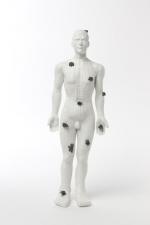
But you are unique in the Dutch jewelry world aren’t you?
Ruudt Peters: Well, I am an alien in the Dutch world, but not unique because now I have many students who are also working in a similar way. I have guided this newer generation to look more at mysticism and to what jewelry could be. Terhi Tolvanen, Evert Nijland, Iris Eichenberg, and Gesine Hackenberg, among others, are examples of students I taught at the Rietveld Academy who look at jewelry from my point of view.
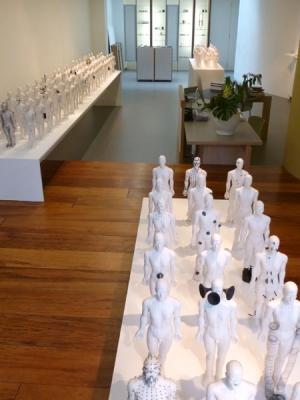
Ruudt Peters: There is a big difference between jewelry that comes from the Netherlands and Germany or China or America. The roots of the country of origin of the maker are a major influence upon the work. For example, Dutch-ness does not lie in the flatness of the countryside but more in conceptual thinking. The Dutch have the ability to think inventively due to the constant battle with rising waters. As a result, they have worked together for generations and have an open and tolerate mindset.
But then, haven’t you really just used your life experience to choose what to make? Who else bases a series on the phallus or Jesus Christ but a gay Catholic man?
Ruudt Peters: Eroticism, sexuality, and religion are some of the strongest forces driving mankind. We do not know why we are here. We do not know what to do with our life. We do not know what to think. All those things are bigger than us. The phallus represents the fertility of life, the driving force to make new generations. It represents outward energy and is a symbol of creativity. Also, I am a gay man, of course. Maybe I am a pervert, but as a young boy the beautiful naked body of Jesus Christ hanging in the church obsessed me. For a long time, I was not able to do anything with these feelings. Two years ago, in the Corpus series, I gave myself the freedom to work with this beautiful body. I created a Christ more humble, endearing, loving, and compassionate with less suffering than the original Jesus Christ.
Looking back on your career, you have taken very big steps with each series you have undertaken, but there is an underlying theme of a searching and longing for something. What is it?
Ruudt Peters: The force and mystery of life, romance, history, and death are the red line in my work. This red line is like a diamond, each time I take a facet and grind it until it shows the real content and power. I force myself to invest in a new subject every time. I am not the artist who makes a continuous line of work. I like to jump and surprise myself by what I can discover.
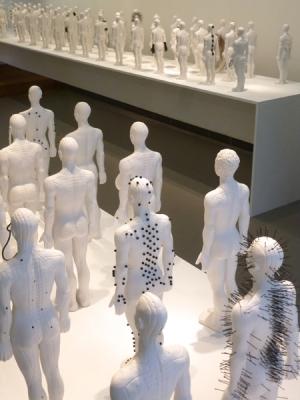
Ruudt Peters: “Jewelry is my laboratory,” means that I am able to experiment as much as possible in a smaller scale. When I make a big sculpture, I am not able to do everything myself. With jewelry, I am able to do everything with my hands. From the first step until the end, it is my own decision. That offers a lot of freedom and energy.
In my opinion, a piece of jewelry or art needs afflatus. This term comes from the Dutch word bezieling. The word is difficult to translate. But it has to do with spirit, soul, and energy. When a jewel has no afflatus, the jewel is dead. In other words, it cannot communicate anything. But, how do you get afflatus into a piece? It’s a mystery. You can’t will yourself to make afflatus in a piece. You have to pay attention so that all your energy, love, dedication, power, and spirit go into the work. In the end, maybe afflatus will show up or maybe not.
Jewelry allows me to make a lot of work, and I have more opportunities to pay attention to the secret of ways of achieving this feeling of the divine creative impulse or afflatus.
There is a wonderful theatricality to the presentation of your work in exhibitions. You use pillows, veils, light bulbs, mirrors, coats, and hangers, among other things. The imagination you have put into this over the years is impressive. What is your thinking about presentation?
Ruudt Peters: With the scenography of my exhibitions, I like to offer the audience a glimpse of the many thoughts I have had about the work without speaking to the viewer. I create an atmosphere of a sacred and respectful place for the pieces and try to involve the viewer in that. The presentation is always related to the body, one way or the other. The viewer is made to be part of the presentation. Sometimes they must kneel to see it, or climb a ladder, or in some way become physically involved. There is an interaction between the object and the audience.
You have started making videos. Why?
Ruudt Peters: I realize that I take big steps in my work, and that sometimes the audience has difficulty following my new ways of thinking. By making videos, I am able to guide the people into my subject. And there is the fact that I like doing it. It’s a great medium. Making movies is like making jewelry—you can’t hide anything.
In the jewelry world, you are known as a provocateur, a demanding teacher, and a critic of the field. What has led you to this role?
Ruudt Peters: I don’t feel that I am a provocateur. I think it is more that others are not expressing their honest opinions. I believe that it is very important to speak out freely about what you feel to increase the levels of honesty within the field, and therefore improve it as a whole. I like to teach, but only to students who are willing to make a difference in their life and with their jewelry. I know I am demanding in my role as teacher. I see too many teachers who are afraid to take a position toward their students. Encouragement is the only way to bring students further, but going deeply into oneself can sometimes be painful.
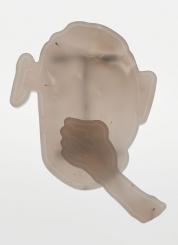
In past interviews, you have pointed out the small size of the brains of both the audience and the makers in this field. You have criticized the makers for producing jewelry without thinking of it as a statement of meaning. Who is an example of a jeweler who you think makes a clear and significant statement of meaning?
Ruudt Peters: The broken bottle necklace by Bernhard Schobinger called Bottleneck (1988) is a very strong piece. You feel Taoism, drunkenness, and aggression in this piece. The violence and aggression splashes off it. Not enough jewelers are sharp and extreme enough in their opinions in making jewelry.
What piece of jewelry has had the greatest influence on you?
Ruudt Peters: For the most part, jewelry doesn’t really inspire me. Usually when I look at it, I don’t have an emotional reaction. My inspiration comes more from the fine arts. I am touched on a deeper level by it. Fine art makers dive deep into the ocean of themselves. This is what is missing in contemporary art jewelry.
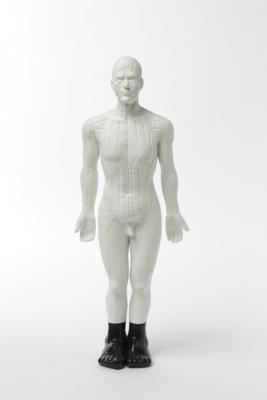
What was the most important exhibition you have seen this year?
Ruudt Peters: There are two. One was Cy Twombly’s flowers in the Museum Brandhorst in Munich. Can you imagine 24 paintings on 240 x 240-cm canvases with 24 extremely powerful red flowers? The whole space was filled up with energy. Afterward, I saw on the wall panels that Cy Twombly made these paintings when he was 88-years-old. What great strength he had, especially for an older man!
Last week I saw Christo’s The Big Air Package in the Gasometer. It is an 88-meter-high textile sculpture inside an old gasometer. When you were lying on the ground, the light of the sculpture was esoteric and pulsating. I had the feeling that I was in the universe.
What kind of jewelry are you drawn to?
Ruudt Peters: I’m attracted to all kinds of jewelry, from art jewelry to fashion jewelry to classical goldsmithing. Also, some fashion designers have very strong ideas about jewelry that intrigue me. Some of the fashion designers I admire are Victor and Rolf, Alexander McQueen, Walter Van Beirendonck, and Carol Christian Poell.
What kind of books are you drawn to?
Ruudt Peters: Between Good and Evil by Rüdiger Safranski is a book that struck me a lot. He is a German philosopher who asks why we are so evil to each other?
Thank you.




